What Does Hibiscus Tea Taste Like
Hibiscus tea, known for its deep red infusion, offers a complex taste experience. When you sip this herbal tea, the first note you'll likely detect is its tartness, akin to that of cranberries. This tangy flavor is the most prominent and is a signature characteristic of the tea.
In contrast to the initial tartness, you'll also find subtle fruity undertones reminiscent of berries, which add a dimension of sweetness to the overall palate. Some people might detect a hint of citrus, which contributes to the tea’s refreshing quality.
The texture of hibiscus tea is usually described as smooth, with a full-bodied mouthfeel that differentiates it from lighter herbal teas. Despite its pronounced flavors, it doesn't overpower, and many describe it as having a clean and refreshing finish.
Bestsellers
Here's a quick profile breakdown:
- Flavor: Tart, slightly sweet
- Fruity Notes: Berries, citrus hints
- Texture: Smooth, full-bodied
- Finish: Clean, refreshing
When you enjoy hibiscus tea, it's important to note that the intensity of these flavors can vary with the concentration of the tea and whether it's served hot or iced. A more concentrated brew will result in a bolder, tart taste, while a diluted version will be milder and possibly more refreshing, particularly when iced. Sweeteners or additional flavorings can also alter the profile, smoothing the tart edges and amplifying the natural fruitiness.
Primary Flavor Notes

When you sip hibiscus tea, you're met with a symphony of flavors that are bold and distinctive. The taste is a rich tapestry woven from sweetness, tartness, and subtle floral undertones.
Sweetness
Although hibiscus tea has a natural hint of sweetness, it is not overly sugary. It carries a mild sweetness akin to cranberries, which can vary depending on the blend or preparation. If you prefer a sweeter taste, you might consider adding a touch of honey or sugar.
Tartness
The predominant flavor that characterizes hibiscus tea is its tartness, reminiscent of that found in lemonade or tart berries. This sharp and refreshing quality makes the tea particularly invigorating.
Floral Undertones
Beneath the dominant tart profile, you'll detect floral undertones that provide a delicate balance to the beverage. These notes can be described as subtly perfumed, evoking a gentle essence that lingers on the palate.
Factors Influencing Taste
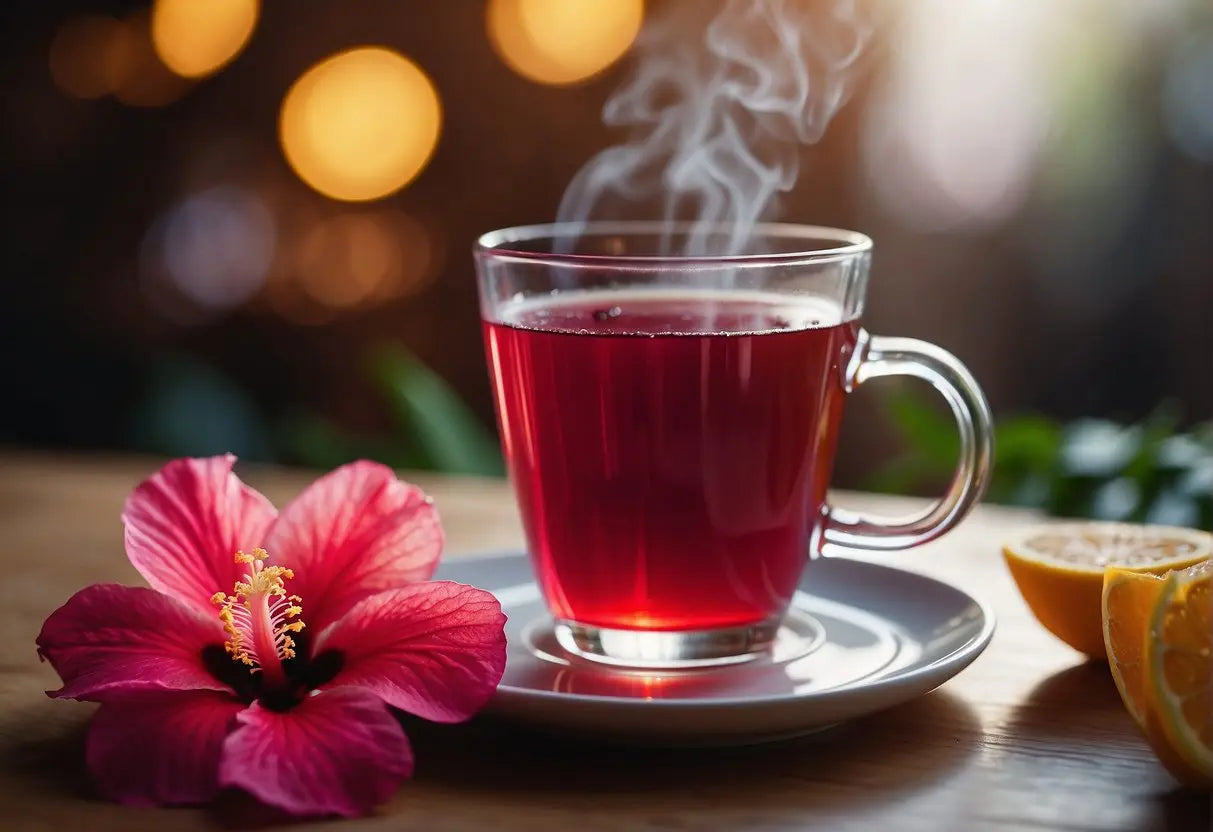
The flavor of hibiscus tea can significantly vary depending on several factors, each playing a crucial role in shaping your tea experience.
Hibiscus Variety
Different species and varieties of hibiscus plants affect the taste of the tea produced. Hibiscus sabdariffa, typically cultivated for tea, yields a tart, cranberry-like flavor. Other varieties might impart subtle differences, making some teas milder or more pungent.
Brewing Time
- Shorter brew time (1-3 minutes): Your tea will have a lighter, more delicate taste.
- Longer brew time (5+ minutes): The tea becomes more intense and tart as the brewing time increases.
Temperature
- Hot water brewing: Enhances the extraction of flavors, resulting in a rich and full-bodied taste.
- Cold brewing: Leads to a smoother, less astringent tea that may require a longer steeping time.
Additives
- Sugar, honey, or sweeteners: These can soften the natural tartness of hibiscus tea.
- Lemon, mint, or spices (e.g., cinnamon): Incorporating additional flavors can create a complex, multi-layered taste profile.
Texture and Mouthfeel

When you sip hibiscus tea, you'll notice its smooth texture. The liquid feels silky as it flows, mostly thin, which is typical for herbal teas. Unlike some thicker beverages, hibiscus tea does not coat the mouth, which makes it particularly refreshing.
Lao Ban Zhang
The absence of tannins, which are prevalent in black and green teas, means that hibiscus tea lacks astringency, so there is no dry, puckering sensation in your mouth. Instead, the tea has a clean finish that leaves a minimal aftertaste.
As you drink, you might perceive a slight viscosity. Here’re some aspects of the mouthfeel you might experience:
- Temperature: Often served hot, impacting the perceived thickness.
- Concentration: A stronger brew may feel fuller in your mouth.
- Sweeteners or Additions: Honey or sugar can alter texture, making it somewhat more viscous.
Enjoying hibiscus tea chilled can offer a different mouthfeel, where the coolness of the beverage further enhances its crisp, clean quality. Whether hot or cold, the tea remains light and hydrating, making it a pleasant drink for both refreshment and leisure.
Color and Appearance
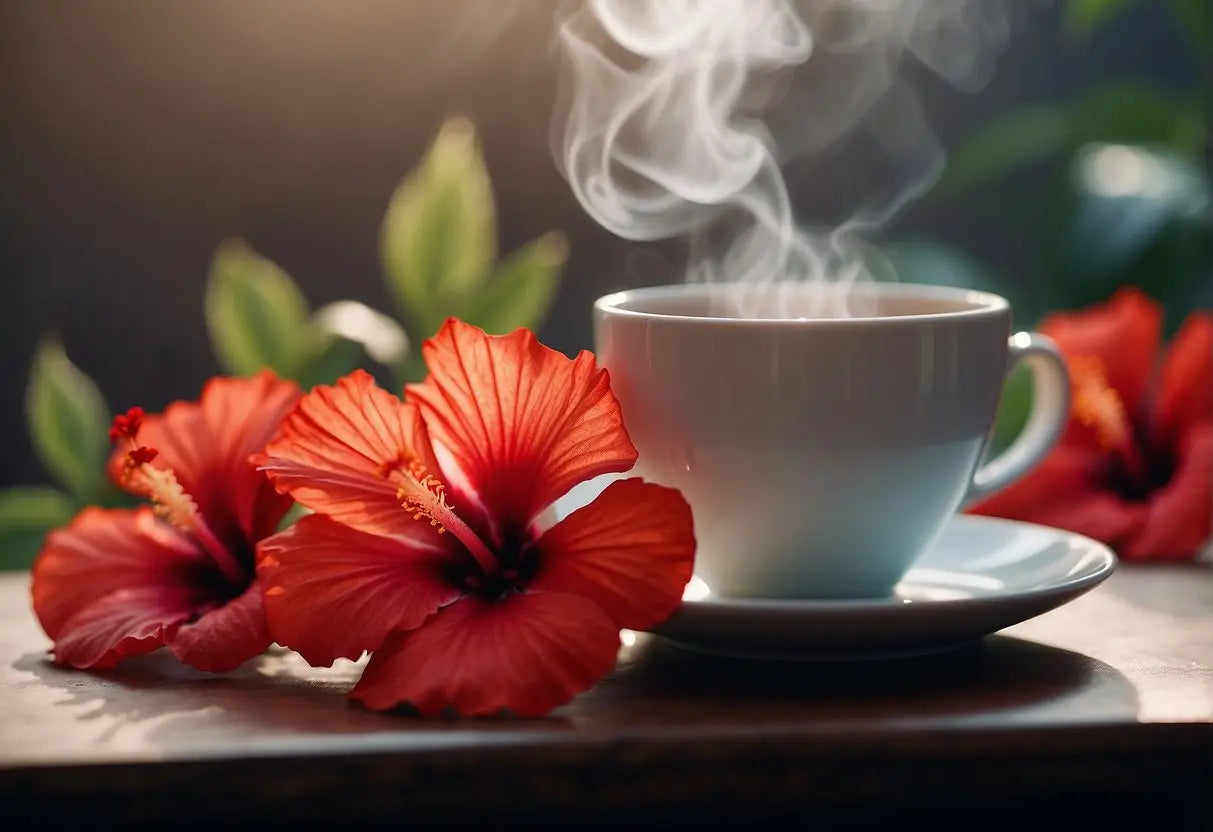
When you brew hibiscus tea, you'll notice it has a vibrant red hue that is both appealing and intense. This color is because of the natural pigments found in hibiscus flowers, called anthocyanins.
- Clarity: Hibiscus tea is typically clear when brewed correctly, without any cloudiness.
- Intensity: Depending on the concentration, your tea can range from a light pink to a deep burgundy.
The visual appeal of the tea can vary:
- Loose Leaves vs. Bagged: Using loose hibiscus flowers may result in a slightly different visual texture compared to bagged tea.
- Brewing Time: A longer steep will produce a denser and darker color.
To enhance your experience with the tea, consider the following:
- Glassware: Clear glass mugs or cups showcase the tea’s beauty.
- Lighting: Natural light can illuminate the tea's color, offering a better appreciation.
Note: Hibiscus tea’s color can be an indicator of its strength and flavor, with darker shades typically signaling a more tart and robust profile.
Culinary Comparisons
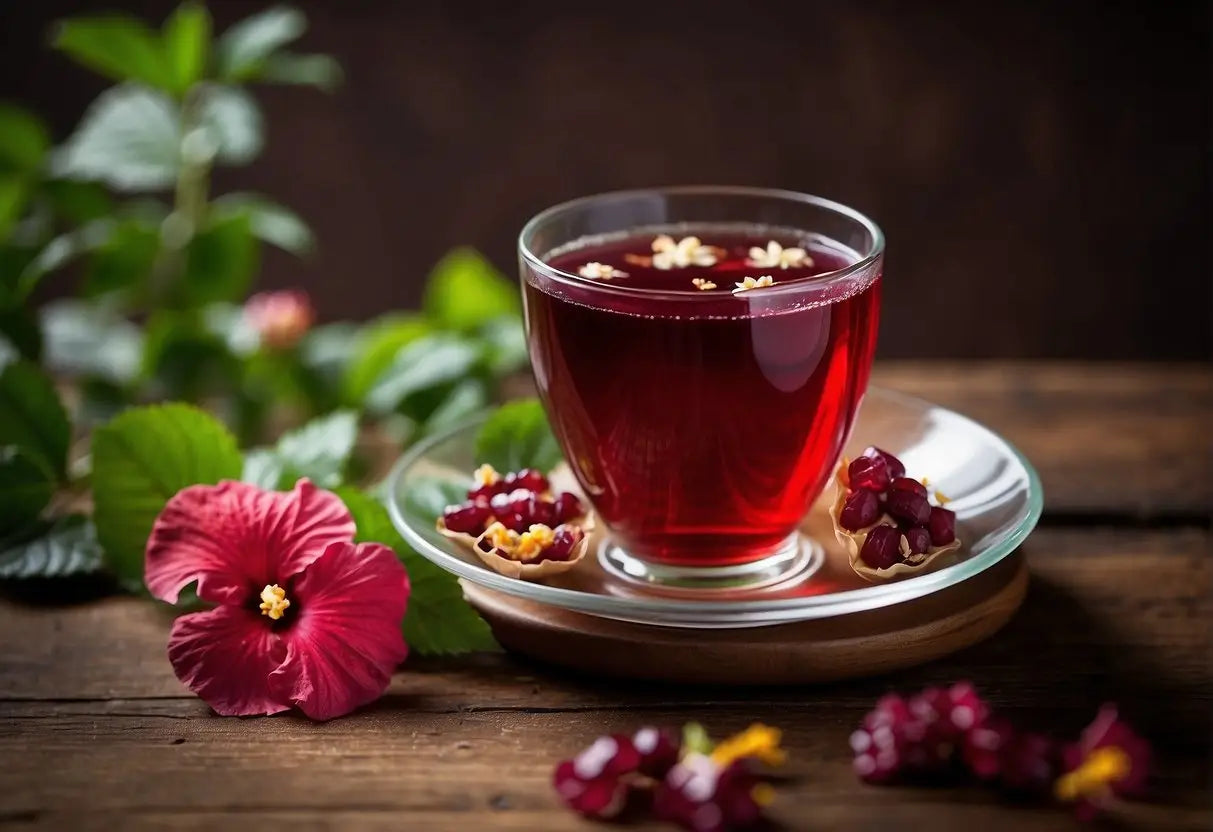
When you sip hibiscus tea, expect a flavor profile that is both tart and tangy, akin to cranberry juice. This tartness is its most prominent feature, and like cranberries, hibiscus can be enjoyed both sweetened and unsweetened, depending on your preference for sweetness.
-
Flavor Notes:
Hibiscus Tea Common Foods Tart Cranberries Tangy Pomegranates Fruity Raspberries Refreshing Lemonade
This herbal tea's inherent zest lends itself well to pairing with sweeteners like sugar, honey, or stevia to balance the tartness. For a deeper exploration of your palate, consider adding spices such as cinnamon, cloves, or ginger, which are often used in teas to add complexity and warmth.
In terms of texture, hibiscus tea has a smooth, pleasant mouthfeel, similar to most fruit teas. It is neither thick nor syrupy, allowing for a light, refreshing experience without any heaviness. To enhance the sensory pleasure, you might combine it with sparkling water for a fizzy variation that's particularly invigorating, especially when served cold on a warm day.
Imagine the profile of hibiscus tea as a less sour, more floral version of lemonade, with the potential to modify its sweetness to suit your taste exactly. It's perfect for those looking for a non-caffeinated beverage that still offers vibrant flavor and versatility in preparation.
Hibiscus Tea Variants
When you explore hibiscus tea, you'll find several variants, each offering a unique flavor profile. Traditionally, hibiscus tea is made from the dried calyces of the Hibiscus sabdariffa flower, resulting in a tart flavor similar to cranberry.
Pure Hibiscus Tea: This is the classic variant with a bold, cranberry-like taste and a deep red color. It is typically unsweetened and can be enjoyed hot or iced.
Blended Hibiscus Teas: Your options include blends with:
- Fruit Flavors: Such as raspberry, lemon, or mango; these combinations can sweeten the tartness of hibiscus.
- Herbs and Spices: Like cinnamon, ginger, or mint; these ingredients add complexity and can balance the tartness.
Hibiscus tea can also vary in flavor due to its preparation:
- Cold Brew Hibiscus Tea: Offers a smoother, less acidic taste.
- Hot Brew Hibiscus Tea: Provides a more intense tartness and astringency.
Decaffeinated Variants: For those sensitive to caffeine, decaffeinated hibiscus teas are available, preserving the flavor without the stimulating effects.
When selecting hibiscus tea, you may also encounter:
- Organic Hibiscus Tea: Cultivated without synthetic fertilizers or pesticides.
- Fair Trade Hibiscus Tea: Ensures ethical sourcing and supports hibiscus-growing communities.
Remember, the specific taste of your hibiscus tea can be further influenced by factors such as the origin of the hibiscus, the harvest time, and the drying process. Enjoy discovering the range of flavors that hibiscus tea variants have to offer.
Health Benefits and Considerations
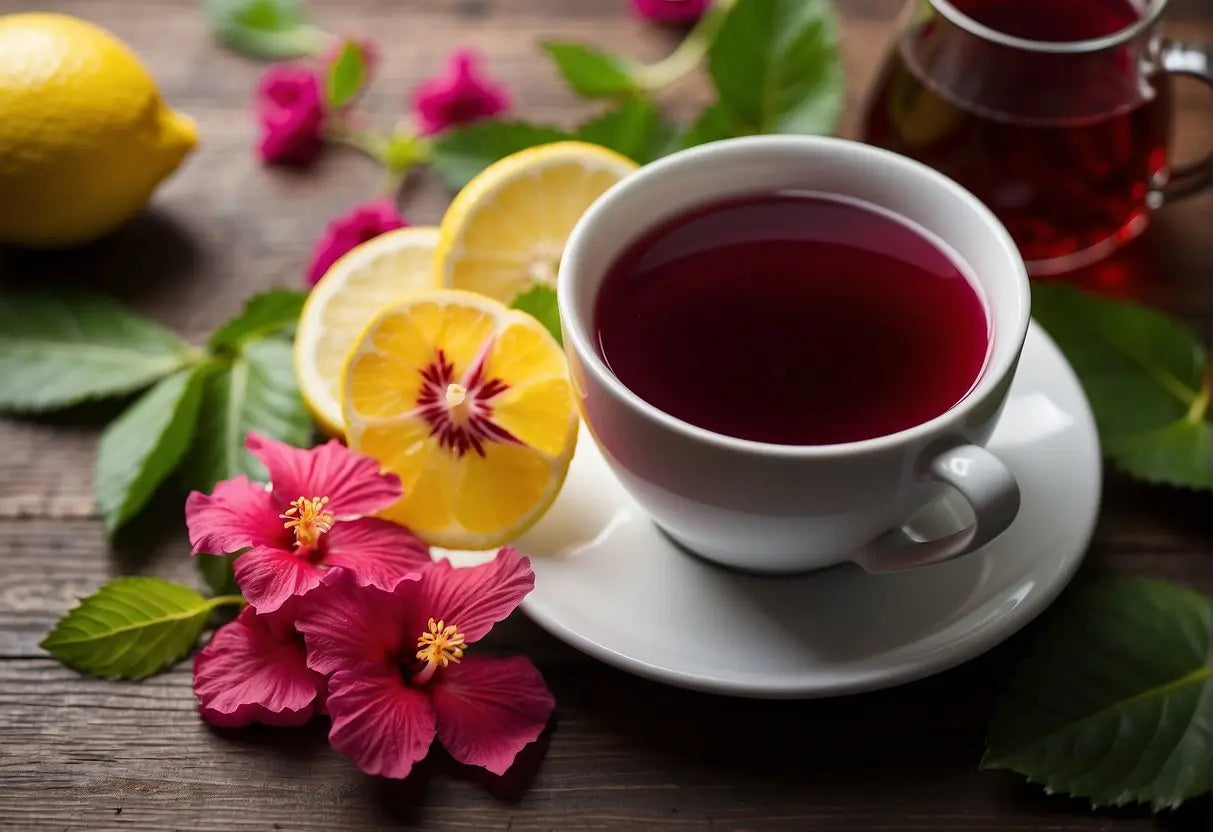
When you consume hibiscus tea, you are not just enjoying its tart and cranberry-like flavor; you are also partaking in a beverage that has several potential health benefits. Hibiscus tea contains vitamin C, minerals, and antioxidants, contributing to its therapeutic properties.
Potential Health Benefits:
- Blood Pressure Management: Regular consumption of hibiscus tea may help in lowering systolic and diastolic blood pressure.
- Liver Health: Hibiscus tea might support liver health due to its antioxidant properties.
- Weight Management: Components found in hibiscus tea can aid in weight control efforts by helping to reduce body weight and body fat.
- Antioxidants: It is rich in antioxidants, which can help protect your cells from damage by free radicals.
| Nutrient | Benefit |
|---|---|
| Vitamin C | Supports immune function |
| Antioxidants | Protects against cell damage |
However, there are a few considerations to keep in mind:
- Hibiscus tea can affect estrogen levels, which means it could potentially interfere with hormone-related medication or conditions.
- Due to its tartness, many hibiscus tea varieties have added sweeteners. If you're watching your sugar intake, look for unsweetened versions or use a modest amount of a sweetener of your choice.
- Drinking hibiscus tea may lower blood pressure; if you already have low blood pressure or are taking medication, consult with your doctor before including it in your routine.
Note: As with any dietary change, it is advisable to consult a healthcare provider, especially if you are pregnant, nursing, or have an existing health condition.
Frequently Asked Questions
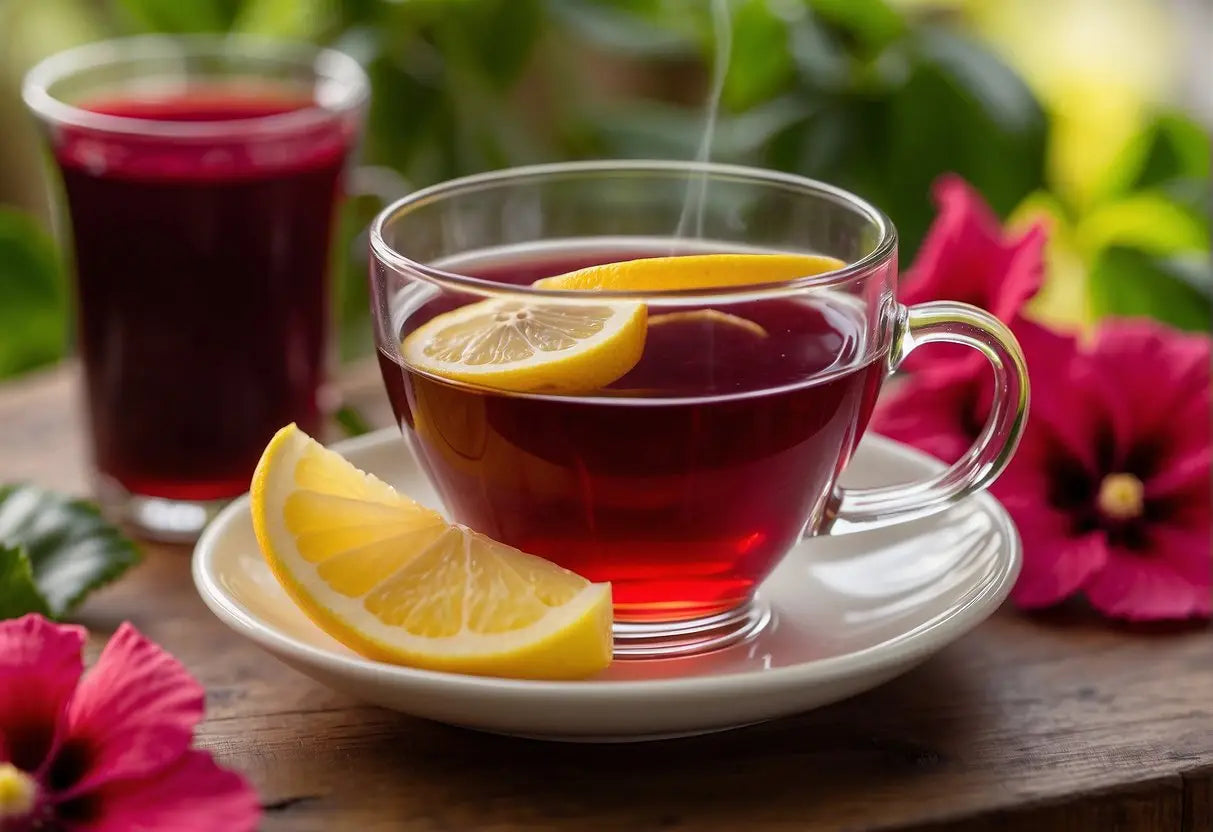
In this section, you’ll find precise and clear answers that cater to the most common inquiries about hibiscus tea, addressing its flavor, health benefits, brewing methods, and more.
Can you describe the flavor profile of hibiscus tea?
Hibiscus tea has a tart flavor reminiscent of cranberries. This unique taste comes from organic acids found in the plant, most notably ascorbic and citric acid.
What are the health benefits associated with drinking hibiscus tea?
Drinking hibiscus tea may lower blood pressure in individuals with mild hypertension. It's also rich in antioxidants which can help combat free radicals in your body.
Are there any adverse effects linked to consuming hibiscus tea?
Hibiscus tea can interact with certain medications and it’s recommended to consult your healthcare provider. High consumption may also cause liver damage.
How does one properly brew hibiscus tea at home?
To brew hibiscus tea, steep dried hibiscus flowers in boiling water for five minutes. For a stronger flavor, you may increase the steeping time.
What are the best practices for consuming hibiscus tea safely?
To consume hibiscus tea safely, it’s advisable to start with a small amount to ensure you don’t have an allergic reaction and avoid it if you're taking prescription diuretics or are pregnant.
How does hibiscus tea compare with other herbal teas in terms of sweetness?
Hibiscus tea is less sweet compared to many herbal teas and often requires additional sweeteners for those who prefer a sweeter taste.
← Older post Newer post →











